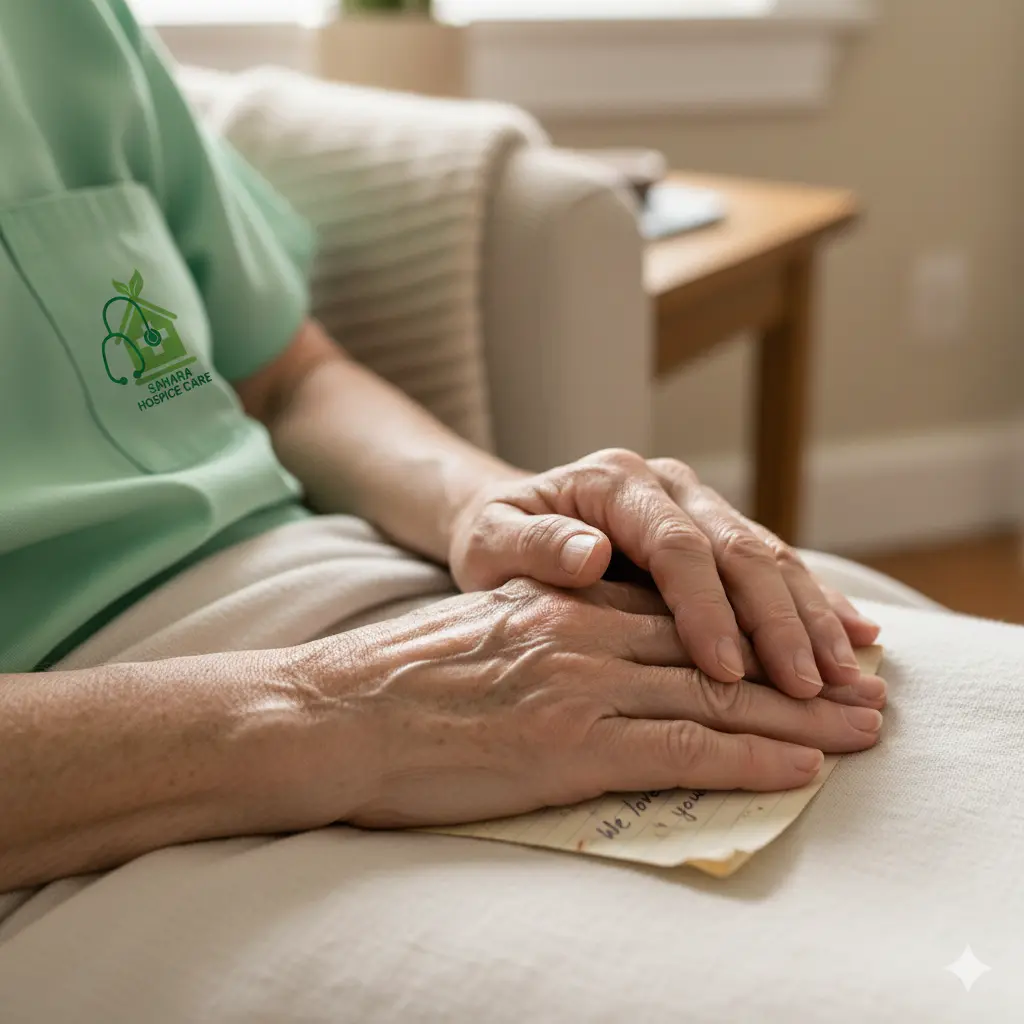When Death Is Near: Clear signs

When Death Is Near: Clear signs & calm next steps
When death is near, families often ask what to expect and how to provide comfort. This guide explains common end-of-life signs, the stages you may notice over days to hours, and simple, compassionate actions to take. If needed, Sahara Hospice Care can start services within 24–48 hours in most cases.
- More sleep and less eating or drinking
- Less communication; confusion or restlessness
- Cool hands/feet; mottling of the skin
- Changes in breathing (Cheyne–Stokes)
- Lower urine output; darker color
- Pain that fluctuates; new grimacing
- Moments of clarity, then deep fatigue

What does it mean when death is near?
The body gradually shifts energy from daily activity to essential functions. Therefore, appetite fades, sleep increases, and circulation slows to the skin and limbs. Families often see mottling, irregular breathing, and longer periods of quiet. Although the pace varies, these changes usually signal the body’s natural closing. For a deeper overview of typical changes, see our
end-of-life signs guide.
End of life signs you may notice in the last weeks
Energy & appetite
People sleep more and eat less. Offer sips of water, soft foods, and lip care. However, do not force intake, which can cause discomfort.
Thinking & mood
Confusion, withdrawal, or brief restlessness can appear. Speak calmly, keep lighting soft, and reduce noise. Music and familiar voices often soothe.
Comfort & pain
Pain may rise as disease advances. Track facial cues and posture. Your hospice team can adjust medications and non-drug comfort methods quickly.
Where care happens
Many families choose home. Others prefer facilities. Learn setting options and practical supports in our
Houston hospice location guide.
When death is near: the last days to hours
In the final days, breathing may become irregular with quiet pauses. Hands and feet can feel cool as circulation slows. Because the body conserves energy, speech may drop to a whisper or stop, yet hearing often remains.
During the last hours, expect shallow breaths, longer pauses, and a relaxed facial expression. You may see purple-bluish mottling on knees, feet, or hands. Stay present, hold a hand, and speak reassuringly. Small acts matter.
Stages of death: a simple, practical timeline
- One to two weeks prior: More sleep, smaller meals, slower movement.
- Days prior: Less conversation, cool limbs, changes in toilet habits.
- Hours prior: Irregular breathing, mottling, minimal responsiveness.
- At passing: Quiet exhale, stillness, and no response.
Every person’s path differs. Consequently, focus on comfort and dignity rather than the clock. Your hospice nurse will guide each step. If you are weighing choices like ventilator use, our
Do Not Intubate (DNI) guide
explains goals-of-care conversations in clear terms.
What to do right now in Sugar Land, Houston
- Call your hospice nurse to review symptoms and adjust the comfort plan.
- Reduce discomfort: Reposition gently, moisten lips, swab mouth, and use cool wipes for fever.
- Honor wishes: Read a favorite prayer, play music, or create a quiet space for family.
- Plan practical support: Ask about medications, equipment, and quick starts for home services. Learn more in our
end-of-life signs article. - Know your local options: See directions and service area details in our
Hospice Houston page.
What do you see when you are dying? Gentle, normal changes
Families may notice distant gazes, soft smiles, or brief clarity after long sleep. This “rally” can happen as energy shifts. It can feel surprising, yet it often signals that the body is completing important goodbyes.
Mini case snapshots (realistic, de-identified)
Before A Houston caregiver called about new mottling and fast-slow breathing. Everyone felt anxious.
After · 12 hours Nurse adjusted meds, taught side-lying positioning, and added mouth care. The patient relaxed, and the family felt confident through a peaceful night.
Before In Sugar Land, a daughter noticed no appetite and confusion. She worried about “starving.”
After · 24 hours Education on the body’s energy shift reduced fear. The team focused on comfort sips and lip balm. Her mom rested calmly while family shared stories.
Helpful, trustworthy resource
FAQs: When death is near
- How long after mottling does death occur?
- It varies widely. Mottling can appear days to hours before death. Your nurse will watch patterns like breathing changes and responsiveness to guide next steps.
- Should we give food or fluids at the very end?
- Offer small sips and moist swabs only if comfortable. Forced intake can cause choking or distress. Comfort care remains the priority.
- What breathing changes are normal?
- Pauses, shallow breaths, or “Cheyne–Stokes” patterns are common. Positioning, a cool room, and medication adjustments can ease distress.
- Can people hear us near the end?
- Hearing may be the last sense to remain. Speak softly, identify yourself, and share simple messages of love and reassurance.
- How do we manage pain at home?
- Track facial tension, guarding, and moans. Then call your hospice nurse. The team can adjust medicines and add non-drug methods quickly.
- Is it normal to have a sudden “rally” before death?
- Yes. Brief clarity or more energy can occur in the final day or hours. Use that time for connection, then expect deep fatigue again.
- Who should we call at the time of death?
- Call your hospice nurse first if enrolled. Otherwise, follow your clinician’s instructions or local guidance. For emergencies, call 911.
Local help when death is near—compassion in hours, not weeks
Call 281-245-9977 · Visit us at 140 Eldridge Rd, Suite B1, Sugar Land, Texas 77478 ·
info@saharahospicecare.com ·
Book a consult
Prefer to read first? Download our “Comfort at the End of Life” checklist to prepare your home and family.

Find us in Sugar Land
